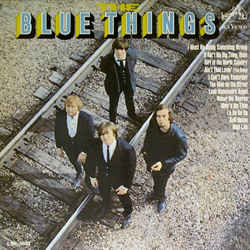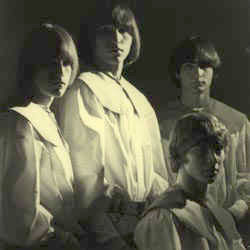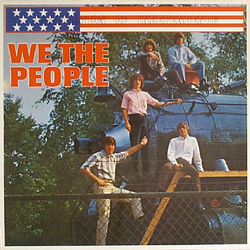What is this all about?
Vernon Joynson Ruined My Life - Jeffrey Lewis
By the time I was about 19 years old I was well obsessed with 60s rock, and I thought I had totally mined the depths of it for
cool psychedelic stuff just because I had Syd Barrett's solo albums, the first 13th Floor Elevators album, some Moby Grape and
some Love. I even had a radio show at my college which I advertised as being "obscure psychedelic 60s music" although at the
time "obscure" meant to me that I'd play Jefferson Airplane songs which were never on regular radio, etc. When I went to
London for the first time, doing a study-abroad semester in Ealing in spring of 1996, I spent a lot of time hanging out
in the TVU school library - just for fun I typed "psychedelic" into the library search computer and a book
called "The Acid Trip: A Complete Guide to Psychedelic Music" written by one Vernon Joynston, came up. Excited at my luck,
I located it on the shelves and took it home.
Have you ever had an experience that was so life changing and mind blowing you can't even remember it?
I honestly have no recollection at all of what my first thoughts were when I started flipping through
this book, a beautiful hardcover 136-page volume, packed with over 200 album cover reproductions,
many in full color, and descriptions/comments on all the albums. All I know is that my paltry
little world of music knowlege, that I thought was so extensive, was completely exploded -
I had no idea WHATSOEVER that there existed a VAST realm of rare and insane albums that were
long out of print, were known by nearly no one, and were seemingly beautiful and strange beyond
anything I had hoped really existed. I took that book out of the library over and over again, and
(after nervously researching the possible penalties for theft, thoughtful wus that I am) I eventually
just never returned it and smuggled it back to the States with me when I returned home that May.
Definitions from All Music Guide (allmusic.com)
Garage Rock - 1960s:
Garage Rock was a simple, raw form of rock & roll created by a
number of American bands in the mid-'60s. Inspired by British
Invasion bands like the Beatles, Kinks, and Rolling Stones, these
midwestern American groups played a variation on British Invasion
rock. Since they were usually young and amateurish, the results
were much cruder than their inspirations but that is what made the
sound exciting. Most of the band emphasized their amateurishness,
playing the same three chords, bashing their guitars and growling
their vocals. In many ways, the garage bands were the first wave
of do-it-yourself punk rockers. Hundreds of garage bands popped
up around America and a handful of them - the Shadows of Knight,
the Count 5, the Seeds, the Standells - had hits, but most were
destined for obscurity. In fact, nearly all of the bands were forgotten
in the early '70s, but the Nuggets compilation brought them back to
the spotlight. In the '80s, there was a garage rock revival that saw
a number of bands earnestly trying to replicate the sound, style, and
look of the '60s garage bands.
Acid Rock - 1960s / 1970s:
Acid Rock was the heaviest, loudest variation of psychedelic rock. Drawing from the overblown blues
improvisations of Cream and Jimi Hendrix, acid rock bands relied on distorted guitars, trippy lyrics,
and long jams. Acid rock didn't last too long — it evolved and imploded within the life span of
psychedelia — and the bands that didn't break up became heavy metal bands.
Psychedelic - 1960s:
Psychedelic Rock emerged in the mid-'60s, as British Invasion and folk-rock bands began expanding
the sonic possibilities of their music. Instead of confining themselves to the brief, concise
verse-chorus-verse patterns of rock & roll, they moved toward more free-form, fluid song structures.
Just as important — if not more so — the groups began incorporating elements of Indian and Eastern music
and free-form jazz to their sound, as well as experimenting with electronically altering instruments and
voices within the recording studio. Initially, around 1965 and 1966, bands like the Yardbirds and the
Byrds broke down the boundaries for psychedelia, creating swirling layers of fuzz-toned guitars, sitars,
and chanted vocals. Soon, numerous groups followed their pattern, including the Beatles and the
Rolling Stones, both of whom recorded psychedelia in 1966. In no time, groups on both sides of the
Atlantic embraced the possibilities of the new genre, and the differences were notable. In Britain,
psychedelia tended to be whimsical and surrealistic. Nevertheless, bands — most notably Pink Floyd
and Traffic — played extended instrumentals that relied on improvisation as much as their American
contemporaries the Grateful Dead, the Doors, Love, and Jefferson Airplane. In other corners of America,
garage bands began playing psychedelic rock without abandoning their raw, amateurish foundation of
three-chord rock — they just layered in layers of distortion, feedback, and effects. Eventually,
psychedelic evolved into acid rock, heavy metal, and art rock, but there continued to be revivals of
psychedelia in the decades that followed, most notably in the American underground of the mid-'80s.
Mod - 1960s:
Technically, Mod refers to a lifestyle and fashion more than music itself. During the early '60s,
legions of teenagers in Great Britain began dressing in stylish, neo-Italian fashions and listening
to American R&B, particularly Motown. Soon, these teens were dubbed mods. The original mod bands were
all R&B cover bands, but soon they began writing their own material that was generally in the vein of
their influences. Mod bands played R&B harder and faster than the original recordings — it was relentless,
amphetamine-driven rock & roll. Many of the mod bands were barely heard outside of the United Kingdom,
since the lifestyle was primarily a British phenomenon. Two bands — the Small Faces and the Who — were
able to crossover to the United States market, but that was after both bands began developing and
expanding their R&B-based sound. By the time psychedelia came around in the late '60s, mod had died out
in Britain. However, mod — both the music and the lifestyle — came back in full force in the late '70s,
thanks to the Jam.
Merseybeat - 1960s:
Merseybeat was the original sound of the British Invasion — a driving, melodic sound that was hybrid of
American rock & roll and R&B, and British skiffle. The Beatles' early records, like "Please Please Me"
and "Love Me Do," were the prototypes of the genre, and soon other Liverpudlian bands like Gerry &
the Pacemakers, Billy J. Kramer, and the Searchers were following the same style. Called Merseybeat
because of the Mersey River in Liverpool, the sound flourished throughout 1963 and the first half of
1964. Shortly afterward, R&B-oriented bands like the Rolling Stones, the Kinks, and the Yardbirds appeared,
as did pop groups like the Hollies and Freddie & the Dreamers. While these pop groups were influenced
by Merseybeat, the style itself was losing ground, especially since the Beatles had begun to expand their
stylistic reach.
British Invasion - 1960s:
The British Invasion occurred in the mid-'60s, when a wave of English rock & roll bands crossed over into
the American market after the breakthrough success of the Beatles. Though not all of the bands sounded
similar — they ranged from the hard rock of the Rolling Stones and the Kinks to the sweet pop of Gerry &
the Pacemakers and Herman's Hermits — each group was heavily influenced by American rock & roll, blues,
and R&B. British Invasion bands were either blues-based rockers or pop/rockers with ringing guitars and
catchy hooks & melodies. Between 1964 and 1966, the British bands dominated the American charts, as well
as the charts in the U.K. In that time, there was a second wave of British Invasion bands — such as the
Who and the Zombies — which was indebted to both American rock and British Invasion pop. By the late '60s,
many of the bands had become rock icons but a greater number didn't survive the transition into
the post-Sgt. Pepper era.



